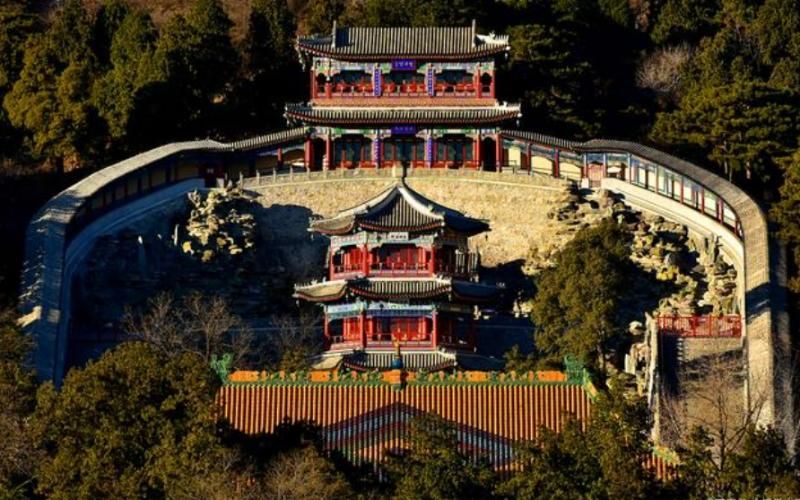Beijing Fragrant Hills Park: Harmony of Nature and History
I. Overview of Beijing Fragrant Hills Park
Situated at the foot of the Western Hills in Haidian District, Beijing, China, Beijing Fragrant Hills Park holds a profound history and rich cultural heritage. Formerly a royal garden, this park has evolved into an ideal destination for urbanites seeking leisure and recreation. Encompassing approximately 160 hectares (395 acres), it features natural pine and cypress forests, maple and smoke trees, persimmon-dotted hills, along with various traditional buildings and cultural relics, creating its distinct landscape.

Reference: Fragrant Hills Park
II. Name and History
The name "Fragrant Hills" originates from its highest peak, Xianglu Peak, symbolizing a serene and fragrant ambiance reminiscent of incense burners. This name may also be associated with the peak's shape, possibly derived from its name.
The Fragrant Hills Pagoda, a significant landmark within the park, was erected in 1780. Despite enduring historical transitions, notably surviving a fire in 1900, it stands as a testament to the park's history.
Construction of the park began in 1186 during the Jin Dynasty, with expansions during the Yuan and Ming Dynasties, further developed during the Qing Dynasty.
In 1745, Emperor Qianlong ordered the construction of palaces, pavilions, and gardens within the park, renaming it "Tranquil Garden," adding a royal touch.
Despite severe damage during the Second Opium War and the Boxer Rebellion in 1860, continuous restoration and development by the Chinese government since 1949 have transformed it into a cornerstone of today's thriving landscape.
III. Features and Attractions of the Park
- Natural Scenery:
The park boasts breathtaking natural landscapes, particularly its autumnal red leaves, which captivate and enchant. Countless crimson leaves blanket the hillsides, creating a magnificent autumnal panorama.
Visitors can traverse the park via cable cars, offering aerial views of this picturesque autumnal haven, marveling at nature's artistry.
- 2. Architecture and Landmarks:
Mirror Lake, Jianxin Hall, Guangming Temple, among others, serve as main attractions, each exuding its unique charm. The Study of Understanding, dating back to the Ming Dynasty, and Guangming Temple, erected in 1780, form a vast complex of Tibetan-style Lamaist temple buildings, steeped in history and cultural significance.
IV. Best Locations and Times for Viewing Red Leaves:
- 1. Tranquil Cuilake: A 5-minute walk from the park's east gate. Surrounded by mountains on three sides, it provides excellent viewpoints for capturing the red leaf scenery. Recommended viewing period is around October 25th to November 9th.
- 2. Fragrant Hills Temple: Situated at the southern foot of Fragrant Hills, adjacent to Shuangqing Villa. Originating from the Tang Dynasty, it serves as the birthplace of Fragrant Hills culture. Best time for red leaf viewing is around October 18th to November 2nd.
- 3. Heshun Gate: Located on the southern slope of the park, approximately 980 feet (300 meters) above ground. Visitors can appreciate red leaves up close from this vantage point. Recommended viewing period is around October 25th to early November.
- 4. Rainflower Show: The largest flat area within the park, about a 20-minute walk away. Its expansive vistas make it an ideal spot for capturing red leaves. Best viewing time is around October 18th to November 4th.
- 5. Fragrant Mist Library: Positioned at the mountain's foot, accessed by climbing a half-hour mountain path. Its classical garden ambiance is intoxicating. Recommended viewing period is from around October 15th to November 4th.
V.Recommended Red Leaf Routes and Notes:
- 1. Route One: From the East Gate to the Summit: Suitable for hiking enthusiasts, passing through Crystal Cuilake, Shuangqing Villa, Fragrant Hills Temple, and Heshun Gate, culminating at the summit, taking about two hours.
- 2. Route Two: From the East Gate to Xiangwukou to the Summit: A gentler route via Rainflower Show, suitable for families.
- 3. Route Three: From the North Gate to the Summit: Accessible for those unwilling to hike uphill, with a 5-minute walk to the cable car station from the North Gate.
Notes:
- - Weekday visits are recommended to avoid weekend crowds.
- - Pay attention to the best time for viewing red leaves to avoid missing the season.
- - Different routes cater to different visitor preferences and physical conditions. Choose accordingly.
VI. Other Attractions
Former Residence of Mao Zedong:
Shuangqing Villa served as Mao Zedong's residence and an early site of the Central Committee of the Communist Party of China, bearing significant historical importance. Visitors can explore the heroic deeds of revolutionary predecessors and the glorious course of the Chinese revolution here.
Located outside the park's north gate, Biyun Temple, though small, holds unique historical and cultural significance. Visitors can experience the allure of traditional Chinese Buddhist culture and savor the exquisite temple architecture and tranquil atmosphere within.
Q: Where is Fragrant Hills Park located?
A: Fragrant Hills Park is situated at the foot of the Western Hills in Haidian District, Beijing, China.
Q: What is the historical significance of Fragrant Hills Park?
A: Originally a royal garden, Fragrant Hills Park has a rich cultural heritage and has evolved into a popular destination for leisure and recreation among urban residents.
Q: What are some of the natural features found in Fragrant Hills Park?
A: Fragrant Hills Park features natural pine and cypress forests, maple and smoke trees, persimmon-dotted hills, and various traditional buildings and cultural relics, creating a unique landscape.